
Holborn is a district in central London, which covers the south-eastern part of the London Borough of Camden and a part of the Ward of Farringdon Without in the City of London.

Fleet Street is a major street mostly in the City of London, England. It runs west to east from Temple Bar at the boundary with the City of Westminster to Ludgate Circus at the site of the London Wall and the River Fleet from which the street was named.
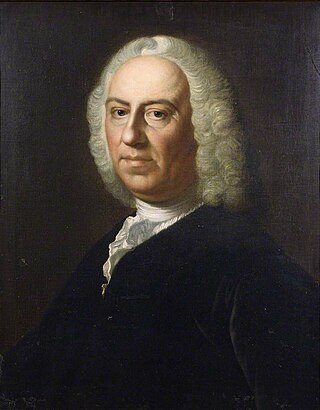
Francesco Xaverio Geminiani was an Italian violinist, composer, and music theorist. BBC Radio 3 once described him as "now largely forgotten, but in his time considered almost a musical god, deemed to be the equal of Handel and Corelli."

Strand is a major thoroughfare in the City of Westminster, Central London. The street, which is part of London's West End theatreland, runs just over 3⁄4 mile (1.2 km) from Trafalgar Square eastwards to Temple Bar, where the road becomes Fleet Street in the City of London, and is part of the A4, a main road running west from inner London.

Temple Bar was the principal ceremonial entrance to the City of London from the City of Westminster. In the middle ages, London expanded city jurisdiction beyond its walls to gates, called ‘bars’, which were erected across thoroughfares. To the west of the City of London, the bar was located adjacent to the area known as the Temple. Temple Bar was situated on the historic royal ceremonial route from the Tower of London to the Palace of Westminster, the two chief residences of the medieval English monarchs, and from the Palace of Westminster to St Paul's Cathedral. The road east of the bar within the City was Fleet Street, while the road to the west, in Westminster, was The Strand.

Temple Bar is an area on the south bank of the River Liffey in central Dublin, Ireland. The area is bounded by the Liffey to the north, Dame Street to the south, Westmoreland Street to the east and Fishamble Street to the west. It is promoted as Dublin's 'cultural quarter' and, as a centre of Dublin's city centre's nightlife, is a tourist destination. Temple Bar is in the Dublin 2 postal district.

The Kit-Cat Club was an early 18th-century English club in London with strong political and literary associations. Members of the club were committed Whigs. They met at the Trumpet tavern in London and at Water Oakley in the Berkshire countryside.
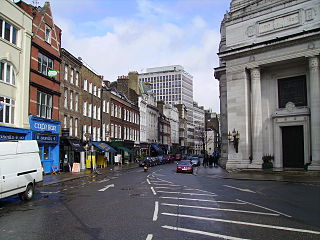
Great Queen Street is a street in the West End of central London in England. It is a continuation of Long Acre from Drury Lane to Kingsway. It runs from 1 to 44 along the north side, east to west, and 45 to about 80 along the south side, west to east. The street straddles and connects the Covent Garden and Holborn districts and is in the London Borough of Camden. It is numbered B402.

The City and Liberty of Westminster was a unit of local government in the county of Middlesex, England. It was located immediately to the west of the City of London. Originally under the control of Westminster Abbey, the local authority for the area was the Westminster Court of Burgesses from 1585 to 1900. The area now forms the southern part of the City of Westminster in Greater London.

Freemasons' Hall in London is the headquarters of the United Grand Lodge of England and the Supreme Grand Chapter of Royal Arch Masons of England, as well as being a meeting place for many Masonic Lodges in the London area. It is located in Great Queen Street between Holborn and Covent Garden and has been a Masonic meeting place since 1775.
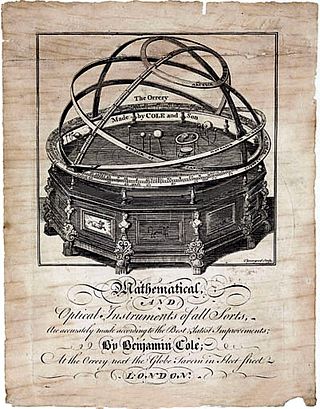
Benjamin Cole (1695–1766) was an English surveyor, cartographer, instrument maker, engraver and bookbinder living in Oxford. His sons William and Benjamin were also instrument makers in London, while another son, Maximilian, was an engraver in Oxford.
Michael Christian Festing was an English violinist and composer. His reputation lies mostly on his work as a violin virtuoso.
A Masonic Temple or Masonic Hall is, within Freemasonry, the room or edifice where a Masonic Lodge meets. Masonic Temple may also refer to an abstract spiritual goal and the conceptual ritualistic space of a meeting.

The Bell Savage Inn was a public house in London, England, from the 15th century to 1873, originally located on the north side of what is now Ludgate Hill, in the City of London. It was a playhouse during the Elizabethan Era, as well as a venue for various other entertainments. It was also an important coaching inn. Other names by which it has been known throughout history include: Savage's Inn, The Bel Savage, Belle Savage, Belle Sauvage, Bell on the Hoop, Old Bell Savage, Belly Savage and others.

Sir Francis Child (1642–1713), of Hollybush House, Fulham, Middlesex and the Marygold by Temple Bar, London, was an English banker and politician who sat in the English and British House of Commons between 1698 and 1713. He served as Lord Mayor of London for the year 1698 to 1699. The goldsmith's business which he built up from 1671 later became one of the first London banks, Child & Co.
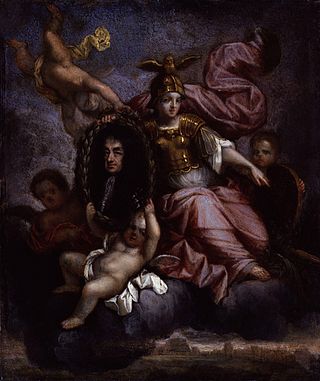
James Parmentier, also known as Jacques Parmentier was a French painter who spent much of his career in England, partly in London and partly in Yorkshire.

Mark Masons' Hall in London is the headquarters of The Grand Lodge of Mark Master Masons of England and Wales, which is also responsible for the Royal Ark Mariner degree. It is located in 86 St James's Street in the central London district of St James's, opposite St James's Palace. While Freemasons' Hall is the headquarters of the United Grand Lodge of England and the Supreme Grand Chapter of Royal Arch Masons of England, Mark Masons' Hall is the home of several other important appendant orders of Freemasonry in England and Wales.

Milford Lane is a narrow street in the City of Westminster that runs from Strand in the north to a brief walkway section leading to Temple Place in the south. It is joined by Little Essex Street and Essex Street on its eastern side. Maltravers Street once joined the lane to Arundel Street, but ceased to exist when building work at 190 Strand was completed.
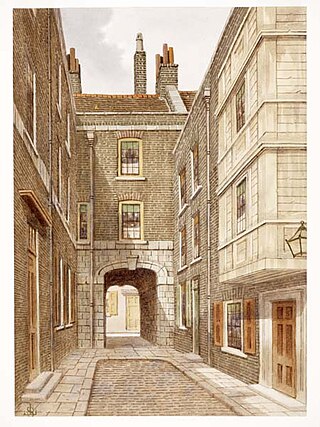
Hanging Sword Alley is an alley in the Alsatia district of London, running between Whitefriars Street and Salisbury Square, close to Fleet Street.

The Devil Tavern, whose full sign was The Devil and Saint Dunstan, was a tavern at number 2, Fleet Street in London, near the Temple Bar. It existed from the reign of James I (1603–25) until it was demolished in 1787 by Child & Co. to expand their banking premises.



















